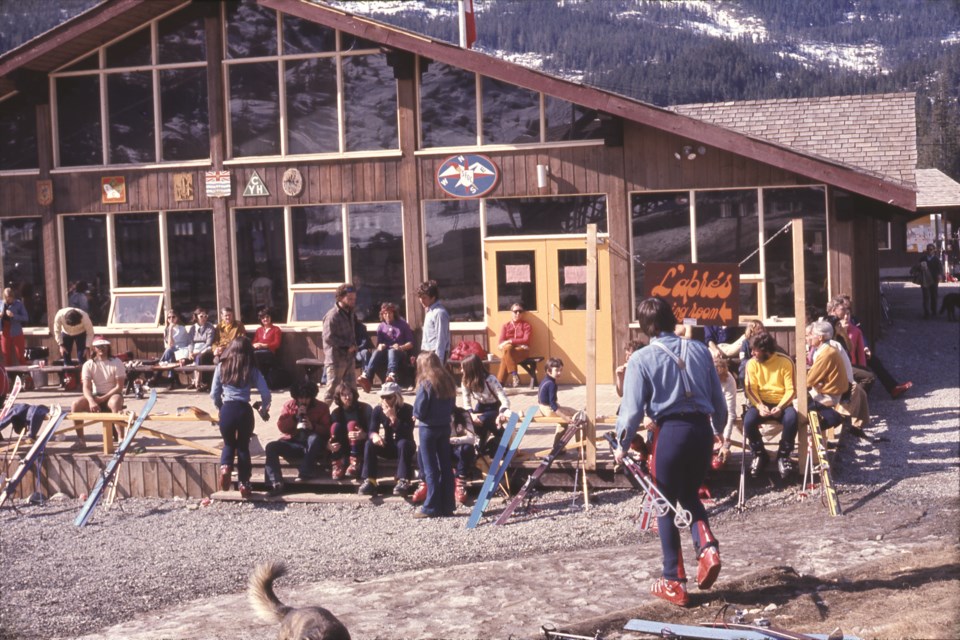When Whistler Mountain opened to visitors in 1966, Franz Wilhelmsen was certain people would bring their own lunch and would not want to purchase food on the mountain. Originally, the only place on the hill to purchase food was Garibaldi Cafeteria near the gondola base on Whistler Mountain (now Creekside).
The cafeteria first opened during construction of the lifts in 1965 to feed the influx of workers. Run by Leo and Soula Katsuris, the cafeteria was nothing fancy, but it fed everyone quickly with limited resources. Once the lifts opened for visitors, the cafeteria transitioned to feeding skiers.
Garibaldi Cafeteria, often known as Whistler Cafeteria or simply “the cafeteria,” quickly became a community hub and remained in operation for more than 15 years. Many of the original members of the volunteer ski patrol remember sleeping in the cafeteria when accommodation was tight. Weekly movie nights also moved to the cafeteria once it opened. This social night was so popular that locals from all around the valley would gather weekly to watch films. Tragically, in the early 1970s, the cafeteria was also home to Whistler’s first recorded murder, when a 20-year-old employee was shot and killed in a random attack.
In 1969, Leo Katsuris opened L’Après next to the cafeteria. Open from lunch until late, L’Après catered to a later crowd with pizza, Greek food and regular live music and parties, becoming Le Club in the evenings. The theme nights, including Beach Party and Western Night, were legendary. Eventually, the Garibaldi Cafeteria was incorporated into the L’Après brand, becoming L’Après Dining Room and Cafeteria, the centre of everything in Whistler at the time. The B.C. liquor board required diners to purchase food in order to buy a drink, and nursing a “plastic cheese sandwich” kept the beer flowing.
Further up the mountain, the hungry skier market was capitalized on almost immediately when (William) Jack Biggin-Pound from Squamish set up a Coleman camp stove and picnic table to serve soup, sandwiches and hot drinks, as well as Mary’s famous cinnamon buns, in the Red Shack at the top of Red Chair. This moved to the Roundhouse after it was built in the summer of 1966 without any dining facilities.
The Katsuris’, who, along with their staff, were known colloquially as ‘The Greeks,” also managed the dining at the Roundhouse, where everything had to be brought up the mountain pre-prepared. There was no power, storage or refrigeration until 1970, when renovations to the Roundhouse brought “a new modern electric food preparation and serving area.” This allowed a larger variety and amount of food to be prepared and served, including hot chocolate, fries, chili, stew, hot dogs and chicken. They also started serving breakfast on the mountain for the first time.
Trying to predict demand was a real guessing game, based largely on the weather. Despite the new facilities, challenges in food preparation and logistics continued, and there were very few updates to the food service on Whistler Mountain over the next 10 years. Before long, the food service gained a poor reputation. According to one story, when the wait time for food at the Roundhouse was long, hamburger patties were only cooked on one side to speed up the cook time. Bob Penner, who lived in Whistler in the 1970s, said the hamburgers at the Roundhouse “made your regular canned meat or tuna taste so much better.”
Once the development of Blackcomb Mountain was announced, the top brass at Whistler Mountain knew they needed to step up their hospitality game. Whistler Mountain Ski Corp took over the existing food venues, redeveloping L’Après into Dusty’s, and, thanks to the competition with Blackcomb, the next decade brought many new and improved on-mountain dining options.




